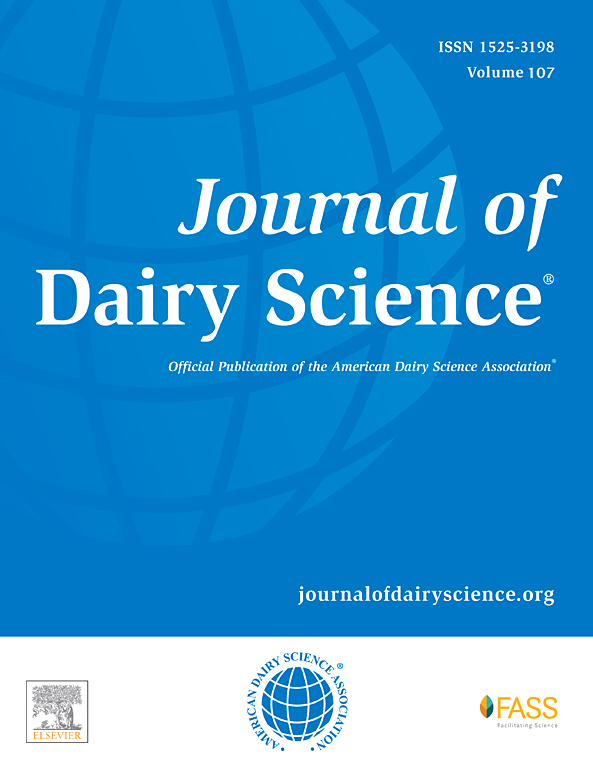Feeding nanoparticles of copper oxide coated with lysine with or without added antagonists affects the copper status but not the performance of Holstein dairy cows
IF 3.7
1区 农林科学
Q1 AGRICULTURE, DAIRY & ANIMAL SCIENCE
引用次数: 0
Abstract
The apparent absorption of copper (Cu) in ruminants is low, with between 0.01 and 0.07 g/g absorbed from sources such as copper oxide (CuO) under typical feeding conditions, resulting in high levels of excretion. Improving the bioavailability of Cu could reduce the supplemental amount required to maintain Cu status and reduce excretion, particularly in the presence of dietary antagonists such as sulfur (S) and molybdenum (Mo). The objective of our study was to determine the Cu status of cows when fed nanoparticle CuO coated with Lys compared with conventional CuO when fed without or in combination with antagonists to Cu absorption (S and Mo) in the diet of dairy cows. Fifty-six multiparous Holstein-Friesian cows that were 48 d ± 17.2 (mean ± SD) postcalving and yielding 41 ± 6.4 kg of milk per day were used in a 2 × 2 factorial design. The 4 treatment groups were: CuO (O-), CuO with added antagonists (O+), nano CuO with a lysine coating (N-), and nano CuO with a Lys coating with added antagonists (N+), fed for 16 wk. We formulated the diets to contain ∼17 mg of Cu/kg DM, and diets with antagonists contained an additional 1 g of S/kg DM and 6 mg of Mo/kg DM, with Lys added to O- and O+ to provide the same daily supply as N- and N+. Blood samples were collected at wk 0, 2, 4, 6, 10, and 16, and liver biopsy samples at wk 0 and 16. We found no effect of dietary treatment on DMI, milk yield, live weight, or BCS, with mean values of 23.3 kg/d, 40.1 kg/d, 646 kg, and 2.68, but milk SCC was higher in cows fed conventional compared with nano CuO, or added compared with no added antagonists. We also found no effect of treatment on blood activity of gamma glutamyl transferase, superoxide dismutase, or ceruloplasmin, hematology profile, or plasma Cu and iron concentration. We found that plasma Mo concentration was increased from 0.36 µmol/L in cows fed O- or N- to 0.80 µmol/L in those receiving O+ or N+. Additional dietary antagonists also decreased the concentration of Cu in the liver of cows fed conventional CuO (C+) over the study period by 1.3 mg/kg DM per day, but in cows fed dietary antagonists and nano CuO coated with Lys (N+), liver Cu concentration was increased by 1.1 mg/kg DM per day. Our study is the first to demonstrate that reducing the particle size of CuO into the nano scale with a lysine coating improves the bioavailability of CuO in the presence of dietary antagonists in dairy cattle, and we did not observe any negative effects on performance or health.
饲喂添加或不添加拮抗剂的赖氨酸氧化铜纳米颗粒会影响荷斯坦奶牛的铜状况,但不会影响其生产性能。
反刍动物对铜(Cu)的表观吸收率很低,在典型的饲养条件下,从氧化铜(CuO)等来源吸收的铜(Cu)在 0.01 至 0.07 克/克之间,因此排泄量很高。提高铜的生物利用率可减少维持铜状态所需的补充量并减少排泄,尤其是在存在硫(S)和钼(Mo)等日粮拮抗剂的情况下。我们的研究旨在确定奶牛在饲喂涂有赖氨酸的纳米颗粒氧化铜时的铜状况,并与奶牛日粮中不添加或与铜吸收拮抗剂(硫和钼)混合添加的传统氧化铜进行比较。采用 2 × 2 因式设计,对产后 48 d ± 17.4(平均 ± SD)、产奶量为 40.6 ± 6.9 kg/d 的 56 头荷斯坦-弗里斯兰多胎奶牛进行研究。4个处理组分别为:氧化亚铜(O-)、添加拮抗剂的氧化亚铜(O+)、带赖氨酸涂层的纳米氧化亚铜(N-)和带赖氨酸涂层并添加拮抗剂的纳米氧化亚铜(N+),饲喂16周。我们配制的日粮含有约 17 毫克铜/千克干物质(DM),添加拮抗剂的日粮含有额外的 1 克 S/ 千克 DM 和 6 毫克 Mo/ 千克 DM,O- 和 O+ 添加了赖氨酸,以提供与 N- 和 N+ 相同的日供给量。在第 0、2、4、6、10 和 16 周收集血液样本,在第 0 和 16 周收集肝脏活检样本。我们发现,日粮处理对DM摄入量、产奶量、活重或体况评分没有影响,平均值分别为23.3 kg/d、40.1 kg/d、646 kg和2.68,但常规饲喂与非氧化铜饲喂或添加拮抗剂饲喂的奶牛牛奶SCC较高。我们还发现,治疗对血液中γ谷氨酰转移酶、超氧化物歧化酶或脑磷脂酶的活性、血液学特征或血浆中铜和铁的浓度没有影响。我们发现,饲喂 O- 或 N- 的奶牛血浆钼浓度从 0.36 µmol/L 增加到饲喂 O+ 或 N+ 的 0.80 µmol/L。在研究期间,额外的日粮拮抗剂也使饲喂常规氧化铜(C+)的奶牛肝脏中的铜浓度降低了 1.3 毫克/千克 DM/天,但饲喂日粮拮抗剂和涂有赖氨酸的纳米氧化铜(N+)的奶牛肝脏中的铜浓度增加了 1.1 毫克/千克 DM/天。我们的研究首次证明,在奶牛饲喂日粮拮抗剂的情况下,用赖氨酸涂层将氧化铜的粒度减小到纳米级可提高氧化铜的生物利用率,而且我们没有观察到对奶牛的生产性能或健康有任何负面影响。
本文章由计算机程序翻译,如有差异,请以英文原文为准。
求助全文
约1分钟内获得全文
求助全文
来源期刊

Journal of Dairy Science
农林科学-奶制品与动物科学
CiteScore
7.90
自引率
17.10%
发文量
784
审稿时长
4.2 months
期刊介绍:
The official journal of the American Dairy Science Association®, Journal of Dairy Science® (JDS) is the leading peer-reviewed general dairy research journal in the world. JDS readers represent education, industry, and government agencies in more than 70 countries with interests in biochemistry, breeding, economics, engineering, environment, food science, genetics, microbiology, nutrition, pathology, physiology, processing, public health, quality assurance, and sanitation.
 求助内容:
求助内容: 应助结果提醒方式:
应助结果提醒方式:


